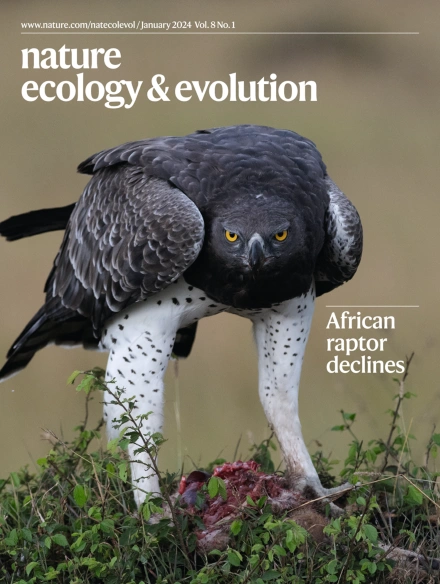Ecological and hydroclimatic determinants of vegetation water-use strategies
IF 13.9
1区 生物学
Q1 ECOLOGY
引用次数: 0
Abstract
Vegetation responses to soil moisture limitation play a key role in land–atmosphere interactions and are a major source of uncertainty in future projections of the global water and carbon cycles. Vegetation water-use strategies—that is, how plants regulate transpiration rates as the soil dries—are highly dynamic across space and time, presenting a major challenge to inferring ecosystem responses to water limitation. Here we show that, when aggregated globally, water-use strategies derived from point-based soil moisture observations exhibit emergent patterns across and within climates and vegetation types along a spectrum of aggressive to conservative responses to water limitation. Water use becomes more conservative, declining more rapidly as the soil dries, as mean annual precipitation increases and as woody cover increases from grasslands to savannahs to forests. We embed this empirical synthesis within an ecohydrological framework to show that key ecological (leaf area) and hydroclimatic (aridity) factors driving demand for water explain up to 77% of the variance in water-use strategies within ecosystem types. All biomes respond to ecological and hydroclimatic demand by shifting towards more aggressive water-use strategies. However, woodlands reach a threshold beyond which water use becomes increasingly conservative, probably reflecting the greater hydraulic risk and cost of tissue damage associated with sustaining high transpiration rates under water limitation for trees than grasses. These findings highlight the importance of characterizing the dynamic nature of vegetation water-use strategies to improve predictions of ecosystem responses to climate change. Vegetation responses to water limitation are difficult to predict due to large variation across space and time. A new analysis of global soil moisture dynamics reveals that water-use strategies vary systematically by vegetation type in response to ecological and climatic conditions.


植被用水策略的生态和水文气候决定因素
植被对土壤水分限制的响应在陆地-大气相互作用中发挥关键作用,是未来全球水和碳循环预测的主要不确定性来源。植被水分利用策略——即植物在土壤干燥时如何调节蒸腾速率——在空间和时间上都是高度动态的,这对推断生态系统对水分限制的反应提出了重大挑战。在这里,我们表明,当全球汇总时,基于点的土壤湿度观测得出的水资源利用策略在气候和植被类型中呈现出紧急模式,沿着对水资源限制的积极到保守反应的光谱。随着土壤的干燥、年平均降水量的增加以及从草原到稀树大草原再到森林的木质覆盖的增加,水的利用变得更加保守,下降得更快。我们将这一经验综合嵌入到生态水文框架中,以表明驱动水需求的关键生态(叶面积)和水文气候(干旱)因素解释了生态系统类型中高达77%的用水策略差异。所有生物群系都通过转向更积极的用水策略来响应生态和水文气候需求。然而,林地达到了一个阈值,超过这个阈值,水的利用就变得越来越保守,这可能反映了在水分限制下,树木比草保持高蒸腾速率所带来的更大的水力风险和组织损伤成本。这些发现强调了描述植被水分利用策略的动态特性对于改善生态系统对气候变化响应的预测的重要性。
本文章由计算机程序翻译,如有差异,请以英文原文为准。
求助全文
约1分钟内获得全文
求助全文
来源期刊

Nature ecology & evolution
Agricultural and Biological Sciences-Ecology, Evolution, Behavior and Systematics
CiteScore
22.20
自引率
2.40%
发文量
282
期刊介绍:
Nature Ecology & Evolution is interested in the full spectrum of ecological and evolutionary biology, encompassing approaches at the molecular, organismal, population, community and ecosystem levels, as well as relevant parts of the social sciences. Nature Ecology & Evolution provides a place where all researchers and policymakers interested in all aspects of life's diversity can come together to learn about the most accomplished and significant advances in the field and to discuss topical issues. An online-only monthly journal, our broad scope ensures that the research published reaches the widest possible audience of scientists.
 求助内容:
求助内容: 应助结果提醒方式:
应助结果提醒方式:


